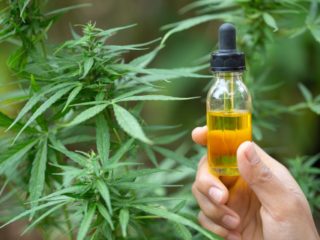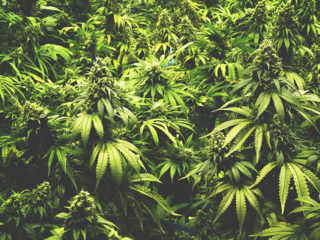You may have heard the word terpenes, or “terps,” being thrown around a lot lately when it comes to cannabis. It’s certainly a popular term right now, as terpenes themselves are clearly having a moment. But what are they? And how do they impact the overall cannabis experience?
Terpenes are essentially the complex compounds that give cannabis plants their unique fragrance and flavor. Until recently, the only way to measure the components of the cannabis plant was to test its cannabinoid levels. In the past, most budtenders and dispensaries have chosen their marijuana based on the overall cannabinoid potency of a particular strain, which has been the main focus of study for the cannabis plant thus far. While that notion certainly makes sense, it turns out that it may not be the only method for evaluating cannabis, as we’ve come to discover that terpenes also have a potency level as well—one that greatly affects the overall appeal of a particular strain of cannabis.
To a customer visiting a dispensary, the barometer for quality, beyond a strain’s look and smell, is its potency of THC and/or CBD. The higher the potency, the “better” the strain, and with such a wide variety of strains to choose from, it can often be tough to narrow down the options. If cannabinoid levels are more or less equal in a group of strains, then what makes one strain different from the other? And that’s where terpenes come in.
In the last few years, we’ve been learning more about terpenes and what’s come to be known as a plant’s “terpene profile,” which is yet another characteristic that makes cannabis so enjoyable. And another characteristic that helps set one strain apart from the other.
So what, exactly, is it that we’ve discovered? Well, for one thing, marijuana is a versatile substance. The complex benefits of it are determined not only by the amount of THC or CBD, but also by the specific terpenes within it. Terpenes are not cannabinoids, but they do occur in the same part of the plant— the trichomes. The trichomes are the resinous oils on the plant, and within this lovely resin you’ll find both cannabinoids and terpenes. Cannabinoids are responsible for the strength of a plant’s therapeutic potency, while terpenes, as we mentioned earlier, are responsible for the smell and flavor. Terpenes readily announce themselves to the senses. They’re what gives the popular Sour Diesel strain its specific essence.
In other words, terpenes are clearly a characteristic worth paying attention to, and in many cases, most of us already do without even realizing it. Every time we pick up a bud and smell or taste it, we’re smelling or tasting that bud’s terpene profile. It’s the terpenes that give each strain of cannabis their distinctive aroma and flavor. But beyond that, the terpenes also have an effect on a plant’s therapeutic characteristics. How much so, nobody really knows just yet, but we are getting close to finding out.
Many of the commonly found terpenes in cannabis are also found elsewhere in nature and have even been proven to aid with inflammation in different parts of the body. Linalool is a terpene that’s also found in lavender, a natural relaxant that’s beneficial for calming anxiety and leveling out stress. Limonene is a citrus terpene, found in fruits, that’s been shown to act as a mood elevator. Beta-caryophyllene is yet another terpene, found in herbs like black pepper and oregano (as well as many vegetables), that’s helpful with treating stomach and digestive problems. There is also myrcene and alpha-pinene, which both offer calming and awakening effects. And that’s just scratching the surface! There are more than a hundred terpenes that exist in the cannabis plant, and more than nine hundred in nature. That’s a whole lot of terps! But the more we learn about and compare them with the effects of their various strains, the more we begin to see a pattern developing.
Terpenes demonstrate that there is more to cannabis than just its THC or CBD content. The effects that terpenes have in conjunction with cannabinoids assist in creating what’s commonly referred to as the “entourage effect.” This interaction of elements can offer a result that is greater than the sum of the individual cannabinoids. The variations of highs that we all love to enjoy can often be attributed in large part to the terpenes. It is for this very reason that we’re beginning to see oil cartridge manufacturers reintroduce terpenes into their cartridges—beyond just the nuance and flavor, they also contribute greatly to a stran’s overall enjoyment.
Every day is a learning experience in the cannabis industry. The plant is evolving at an extremely fast pace right now, and thankfully the legalization evolving with it—while regretfully not at the same pace—is still allowing for more research and investigation into the true science behind our buds. Terpenes are certainly not unique to just the cannabis plant, and like the many strains and varieties of cannabis, there are many varieties of terpenes. But as we learn and uncover more about terpenes and their effects, we learn more about what makes one particular strain more enjoyable than another, and ultimately discover which strains suit us best.
So the next time you visit a dispensary, perhaps pay less attention to a strain’s actual THC or CBD numbers and more attention to its overall appeal—take a deep sniff and indulge in the flower’s unique aroma. Then, if your budtender allows, light it or vape it and savor its unique taste and flavor. All that, my friends, are the terpenes fiddling with your senses—and what’s not to like about that?
By Chris Fisher











